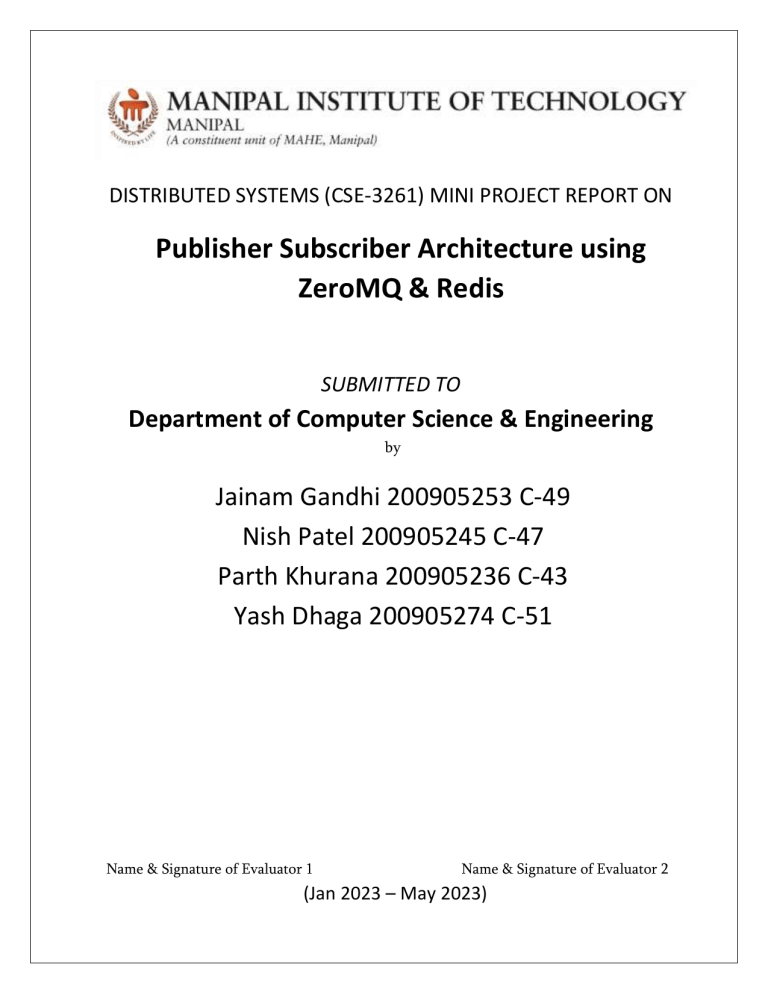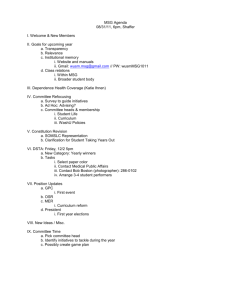
DISTRIBUTED SYSTEMS (CSE-3261) MINI PROJECT REPORT ON
Publisher Subscriber Architecture using
ZeroMQ & Redis
SUBMITTED TO
Department of Computer Science & Engineering
by
Jainam Gandhi 200905253 C-49
Nish Patel 200905245 C-47
Parth Khurana 200905236 C-43
Yash Dhaga 200905274 C-51
Name & Signature of Evaluator 1
Name & Signature of Evaluator 2
(Jan 2023 – May 2023)
Table of Contents
Page No
Chapter 1
INTRODUCTION
3
1.1
Introduction to Publisher Subscriber Architecture
3
1.2
Introduction to ZeroMQ
3
1.3
What is the Redis?
4
Chapter 2
BACKGROUND THEORY and/or LITERATURE REVIEW
4
2.1
General Mechanism of Pub-Sub Model
4
2.2
Integration of ZeroMQ and Redis
5
Chapter 3
METHODOLOGY
6
Chapter 4
RESULTS AND DISCUSSION
12
Chapter 5
CONCLUSIONS AND FUTURE ENHANCEMENTS
13
REFERENCES
14
2
1. INTRODUCTION
This mini project aims to implement the Publisher-Subscriber Architecture using Python ,ZeroMQ
and Redis.
1.1 Introduction to Publisher Subscriber Architecture
The publisher-subscriber architecture, also known as the pub/sub architecture, is a messaging pattern
used in software design to enable communication between different components of a system. It is a
type of event-driven architecture that allows decoupling of components by removing the direct
coupling between the sender and receiver of messages.
In the publisher-subscriber architecture, there are two main actors: the publisher and the subscriber.
The publisher is responsible for generating and broadcasting messages, while the subscriber receives
and processes those messages. This enables asynchronous communication between components and
allows for scalability, flexibility, and modularity in the system.
1.2 Introduction to ZeroMQ
ZeroMQ (also known as ØMQ) is a messaging library that provides a lightweight, low-level
communication protocol for distributed and concurrent applications. ZeroMQ is designed to be fast,
scalable, and reliable, and it supports a variety of messaging patterns, including the publish-subscribe
pattern.
ZeroMQ is often used in high-performance computing, financial trading systems, and other
applications that require low-latency, high-throughput messaging. One of the key benefits of
ZeroMQ is its ability to handle large volumes of data with low overhead, making it an efficient
choice for applications that require high-performance messaging.
ZeroMQ supports a variety of programming languages, including C, C++, Python, Java, and many
others, and it runs on a wide range of operating systems. ZeroMQ is also designed to be highly
customizable, with a modular architecture that allows developers to build custom messaging patterns
and protocol
3
1.3 What is the Redis?
Redis (Remote Dictionary Server) is an open-source, in-memory data structure store that can be used
as a database, cache, and message broker. Redis supports a variety of data structures, including
strings, hashes, lists, sets, and sorted sets, and provides a number of advanced features such as
transactions, pub/sub messaging, and Lua scripting.
Redis is designed to be fast, scalable, and highly available, making it an ideal choice for applications
that require high-performance data storage and retrieval. Because Redis stores data in memory, it is
able to deliver extremely fast read and write performance, especially for frequently accessed data.
One of the key features of Redis is its support for pub/sub messaging, which allows applications to
send messages to multiple subscribers in a scalable and efficient way. Redis pub/sub messaging can
be used to build real-time applications such as chat rooms, real-time analytics, and data streams.
Redis is commonly used in a variety of applications, including e-commerce, social networking, and
real-time analytics. It is available as a self-hosted solution or as a managed service in the cloud, and
it supports a variety of programming languages, including Python, Java, and C#.
2. BACKGROUND THEORY and/or LITERATURE REVIEW
2.1 General Mechanism of Pub-Sub Model
In this model, there are two main actors: the publisher and the subscriber. The publisher is
responsible for generating and broadcasting messages, while the subscriber receives and processes
those messages.
The general mechanism of the publisher-subscriber model involves the following steps:
1. The publisher generates a message and sends it to a message broker or middleware, which serves
as an intermediary that receives and routes messages between the publisher and the subscribers.
2. The message broker then delivers the message to all interested subscribers that have registered to
receive messages of a certain type or topic.
3. The subscribers receive the message and process it according to their specific requirements.
4. If necessary, the subscribers can send a response back to the publisher or another component of
the system.
One of the key advantages of the publisher-subscriber model is that it allows for asynchronous
communication between components. Publishers can broadcast messages to multiple subscribers
without having to wait for a response, enabling parallel processing and improved performance.
4
2.2 Integration of ZeroMQ and Redis
ZeroMQ and Redis can be integrated to create a powerful messaging system that combines the high
performance and low latency of ZeroMQ with the persistence and durability of Redis.
The integration of ZeroMQ and Redis for the publisher-subscriber model can be achieved in the
following way:
1. The publisher generates a message and sends it to a ZeroMQ socket.
2. ZeroMQ routes the message to Redis, where it is stored in a Redis list or channel.
3. Interested subscribers subscribe to the Redis channel or list and receive any new messages that are
published to it.
4. When a subscriber receives a message, it processes it as required.
5. If necessary, the subscriber can send a response back to the publisher or another component of the
system through a ZeroMQ socket.
This integration provides several advantages over using either ZeroMQ or Redis alone. By using
Redis, messages can be persisted, allowing subscribers to retrieve missed messages or recover from
system failures. At the same time, ZeroMQ provides fast, low-latency message delivery, enabling
high-performance communication between components.
Additionally, Redis can be used as a message broker for multiple ZeroMQ publishers and
subscribers, allowing for a scalable and distributed messaging system.
ZeroMQ and Redis can be integrated to create a powerful messaging system that combines the high
performance and low latency of ZeroMQ with the persistence and durability of Redis.
Overall, the integration of ZeroMQ and Redis provides a robust, high-performance messaging
system that is well-suited to a variety of use cases.
5
3. METHODOLOGY
The implementation of a publisher-subscriber model depends on the specific messaging system and
tools being used. However, the general steps involved in implementing a publisher-subscriber model
are as follows:
1. Design the message format: Decide on the format of the messages that will be sent between the
publishers and subscribers. This may include the data to be sent, the message structure, and any
metadata that needs to be included.
2. Choose a messaging system: Select a messaging system that supports the publisher-subscriber
model, such as ZeroMQ, Redis, or MQTT. The choice of messaging system will depend on factors
such as performance, scalability, reliability, and ease of use.
3. Set up publishers and subscribers: Create instances of the publisher and subscriber components
and configure them to use the chosen messaging system. The publisher should be configured to
generate messages and publish them to the messaging system, while the subscriber should be
configured to receive messages from the messaging system.
4. Define message topics: Define the topics or channels that messages will be published to and
subscribed from. Topics can be used to categorize messages and enable subscribers to selectively
receive messages of interest.
5. Implement message processing: Define the actions that will be taken by the subscribers when they
receive messages. This may include processing the message data, updating application state,
triggering other actions, or sending responses back to the publishers.
6. Test and refine: Test the implementation and refine as needed to ensure that messages are being
delivered correctly and that the system is performing as expected.
6
Some tools and frameworks provide built-in support for the publisher-subscriber model, making it
easier to implement. For example, in the case of ZeroMQ, the zmq library provides a set of highlevel abstractions that simplify the creation of publishers and subscribers, as well as the
configuration of message topics and message processing.
Message.py:
from redis_connector import redis_connection
def get_topic_msg_key(topic, msg_id, delimiter=":"):
key = 'TOPIC{delimiter}{topic}{delimiter}MESSAGE{delimiter}{msg_id}'.format(
topic=topic, msg_id=msg_id, delimiter=delimiter
)
return key
def get_topic_msg_read_key(topic, msg_id, sub_id, delimiter=":"):
key =
'SUBSCRIBER{delimiter}{sub_id}{delimiter}READ{delimiter}TOPIC{delimiter}{topic}{
delimiter}MESSAGE{delimiter}{msg_id}'.format(
topic=topic, msg_id=msg_id, sub_id=sub_id, delimiter=delimiter
)
return key
def get_topic_key_pattern(topic, delimiter=':'):
key = 'TOPIC{delimiter}{topic}{delimiter}MESSAGE{delimiter}*'.format(
topic=topic, delimiter=delimiter
)
return key
def extract_msg_id_from_topic_msg_key(topic_msg_key):
return topic_msg_key[topic_msg_key.rfind(':')+1:]
def write_msg(topic, msg_id, msg, ttl=180):
msg_key = get_topic_msg_key(topic, msg_id)
redis_connection.set(msg_key, msg)
redis_connection.expire(msg_key, ttl)
def get_msg(topic, msg_id):
7
msg_key = get_topic_msg_key(topic, msg_id)
msg = redis_connection.get(msg_key)
return msg
def get_msg_by_key(topic_msg_key):
return redis_connection.get(topic_msg_key)
def pop_msg(topic, msg_id):
msg_key = get_topic_msg_key(topic, msg_id)
msg = redis_connection.get(msg_key)
redis_connection.delete(msg_key)
return msg
def mark_msg_as_read(topic, msg_id, sub_id):
topic_msg_read_key = get_topic_msg_read_key(topic, msg_id, sub_id)
msg_key = get_topic_msg_key(topic, msg_id)
redis_connection.set(topic_msg_read_key, 1)
redis_connection.expire(topic_msg_read_key, redis_connection.ttl(msg_key))
def is_msg_read(topic, msg_id, sub_id):
topic_msg_read_key = get_topic_msg_read_key(topic, msg_id, sub_id)
return redis_connection.get(topic_msg_read_key) is not None
def get_msgs_for_topic(topic):
topic_key_pattern = get_topic_key_pattern(topic)
yield from redis_connection.scan_iter(match=topic_key_pattern, count=100)
Publisher.py:
import zmq
import random
import sys
import time, json, uuid
import message as MSG
pub = None
def connect(host="*", port=5555):
global pub
8
if pub is None:
context = zmq.Context()
pub = context.socket(zmq.PUB)
pub.bind("tcp://{}:{}".format(host, port))
return pub
def publish(topic, msg):
msg_id = str(uuid.uuid4())
MSG.write_msg(topic, msg_id, msg)
pub.send_string("{} {}".format(topic, msg_id))
if __name__ == "__main__":
port = int(input("Enter port: "))
connect(port=port)
while True:
topic = input("Enter topic name: ")
msg = input("Enter message: ")
if msg in ('stop', 'exit'):
break
publish(topic, msg)
Subscriber.py:
import sys
import zmq
import message as MSG
import settings
sub_id = None
def process_raw_msg(topic, msg):
print("Received on topic {}: {}".format(topic, msg))
def fetch_and_process_msg(topic, msg_id):
global sub_id
if not MSG.is_msg_read(topic, msg_id, sub_id):
9
msg = MSG.get_msg(topic, msg_id)
if msg is not None:
process_raw_msg(topic, msg)
MSG.mark_msg_as_read(topic, msg_id, sub_id)
else:
print("Message has already been read!")
def process_pending_msgs(*topics):
for topic in topics:
for topic_msg_key in MSG.get_msgs_for_topic(topic):
topic_msg_key = topic_msg_key.decode()
msg_id = MSG.extract_msg_id_from_topic_msg_key(topic_msg_key)
print("Pending message found on topic {}".format(topic))
fetch_and_process_msg(topic, msg_id)
def subscribe(port, topics=[]):
context = zmq.Context()
# sub = context.sub(zmq.SUB)
sub = context.socket(zmq.SUB)
print("Waiting for messages...")
sub.connect("tcp://localhost:{}".format(port))
topics.extend(settings.GLOBAL_TOPICS)
topics = list(map(lambda t: t.strip(), topics))
for topic in topics:
sub.setsockopt(zmq.SUBSCRIBE, topic.encode())
process_pending_msgs(*topics)
while True:
topic_msg = sub.recv().decode()
print("New message: ", topic_msg)
for_topic = topic_msg[:topic_msg.find(' ')]
msg_id = topic_msg[topic_msg.find(' ') + 1:]
fetch_and_process_msg(for_topic, msg_id)
10
if __name__ == "__main__":
sub_id = input("Enter subscriber id(alphanumeric): ")
port = int(input("Enter port: "))
topics = input("Enter topic names(comma-separated) to subscribe to: ")
subscribe(port, topics.split(","))
Redis_connector.py:
import redis
import settings
print ("Initialization - Redis connection pool")
redis_conn_pool =
redis.ConnectionPool(host=settings.REDIS_CONF.get('REDIS_HOST', 'localhost'),
port=settings.REDIS_CONF.get('REDIS_PORT', 6379),
db=settings.REDIS_CONF.get('REDIS_DB', 0),
password=settings.REDIS_CONF.get('REDIS_PASSWORD', ''))
redis_connection = redis.Redis(connection_pool=redis_conn_pool)
Settings.py:
GLOBAL_TOPICS = ["GLOBAL","GENERAL"]
REDIS_CONF = {
'REDIS_HOST': '127.0.0.1',
'REDIS_PORT': 6379,
'REDIS_DB': 0
}
11
4. RESULTS AND DISCUSSION
12
5. CONCLUSIONS AND FUTURE ENHANCEMENTS, IF ANY
In conclusion, the publisher-subscriber model is a messaging pattern used in software architecture to
enable communication between different components of a system. It involves two main actors, the
publisher and the subscriber, where the publisher generates and broadcasts messages, and the
subscriber receives and processes those messages.
The publisher-subscriber model enables asynchronous communication between components,
allowing parallel processing and improved performance. It also promotes the separation of concerns
between components, leading to greater modularity and ease of maintenance. Additionally, the
model allows for decoupling between components, making the system more flexible and adaptable to
changes.
The publisher-subscriber model can be implemented using various messaging systems, such as
ZeroMQ and Redis, which can be integrated to create a powerful messaging system that combines
high performance, low latency, persistence, and durability.
Overall, the publisher-subscriber model is a useful messaging pattern that can be applied to various
use cases, providing efficient and flexible communication between components of a system.
There are several advancements that can be made to the publisher-subscriber model to further
improve its performance, flexibility, and usability. Some of these advancements include:
1. Scalability: One area of improvement for the publisher-subscriber model is in scalability. As
systems grow larger and more complex, it becomes more challenging to manage the large volume of
messages being exchanged. Techniques such as load balancing and sharding can be used to improve
scalability by distributing the load across multiple servers or clusters.
2. Security: Another area for improvement is security. The publisher-subscriber model can be
vulnerable to attacks such as man-in-the-middle attacks or unauthorized access to message content.
Implementing secure communication protocols such as SSL/TLS can help to address these security
concerns.
3. Interoperability: A further area for improvement is interoperability. The publisher-subscriber
model can benefit from improved interoperability with other messaging systems and protocols. For
example, integrating with other messaging systems such as RabbitMQ or Apache Kafka can enable
greater flexibility and expand the range of use cases for the publisher-subscriber model.
4. Real-time capabilities: Another area for improvement is real-time capabilities. Many applications
require real-time communication between components, and the publisher-subscriber model can
benefit from faster message delivery and reduced latency. Techniques such as using in-memory data
structures, optimizing network traffic, and reducing message size can all help to improve real-time
capabilities.
13
5. Management and monitoring: Finally, better management and monitoring tools can help to
improve the publisher-subscriber model. Advanced management tools can provide greater visibility
into message traffic, enable better resource allocation, and facilitate faster response times in the event
of system failures.
Overall, there is significant potential for advancements in the publisher-subscriber model, with many
opportunities for improved performance, security, interoperability, real-time capabilities, and
management and monitoring.
6. REFERENCES
1. "Distributed Systems: Principles and Paradigms" by Andrew S. Tanenbaum and Maarten
Van Steen.
2. https://ably.com/topic/pub-sub
3. Redis documentation
14



